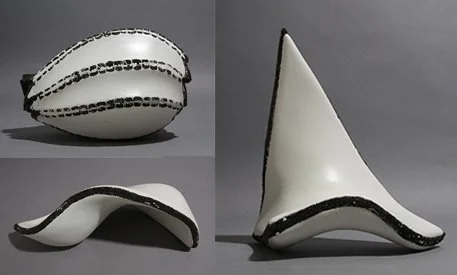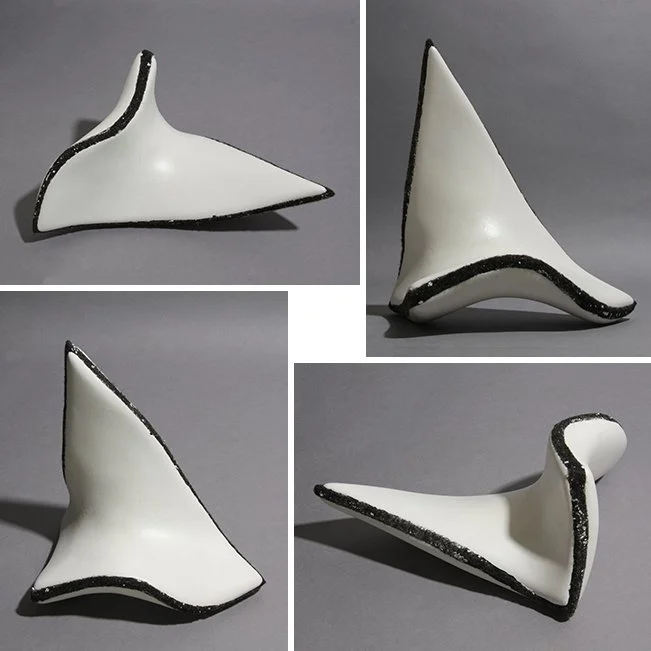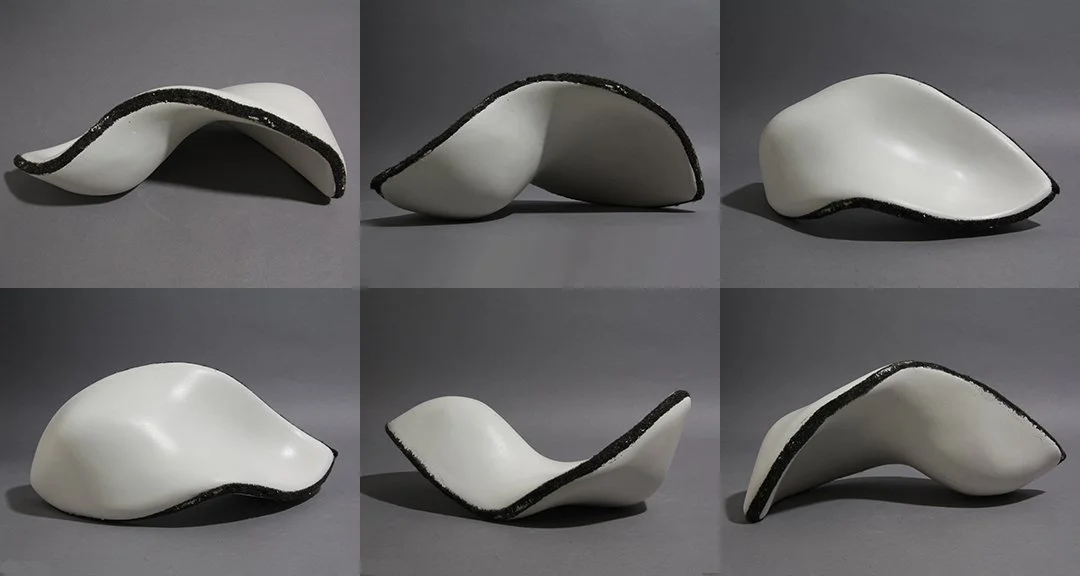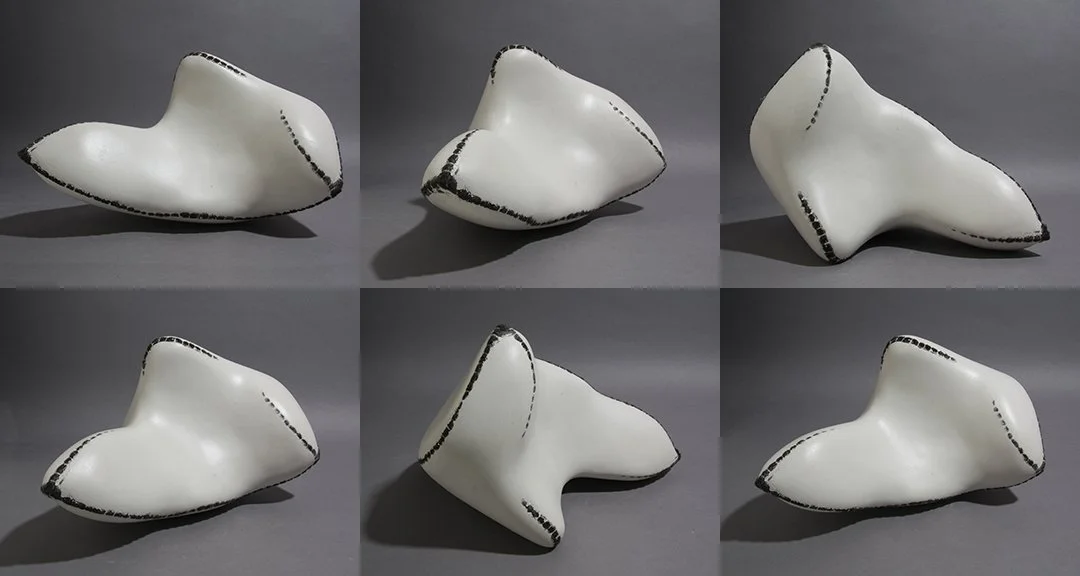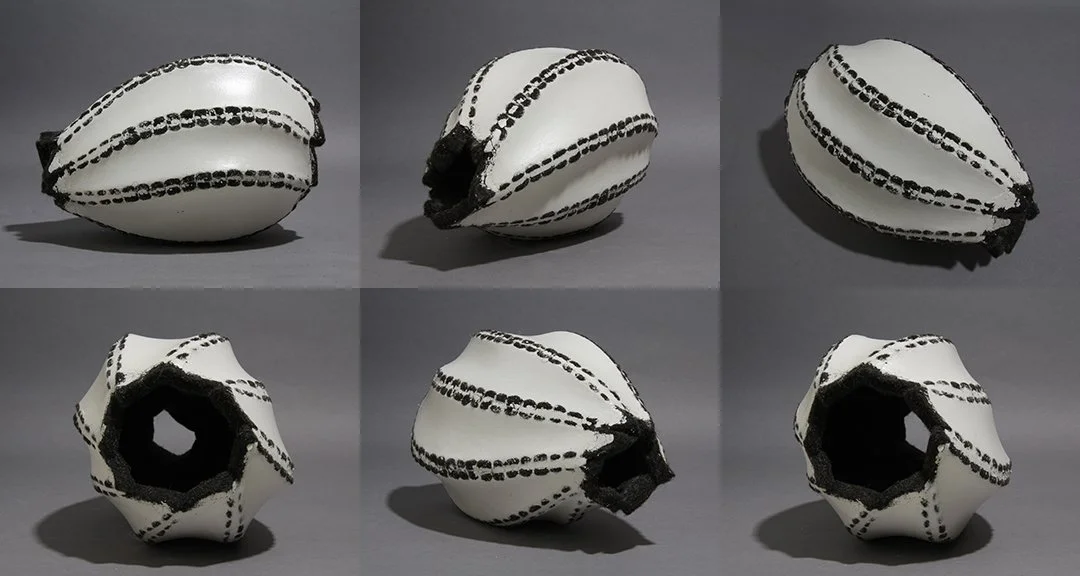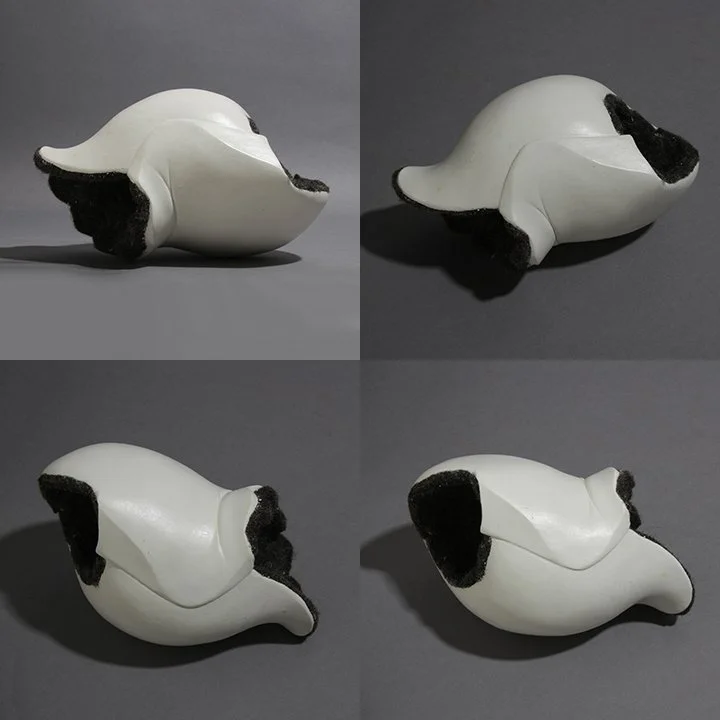Plaster + Felt =?
I just read a quote that resonated with me so deeply: “A creative person isn’t someone who has ideas. It’s someone who’s not afraid to try them.” It was attributed to “an MIT researcher” whom I have not been able to find and name. But the sentiment remains. We all have lots of weird ideas throughout our lives. Taking them from the realm of thought to the real world does take, at the very least, a willingness to fail. Sometimes it’s a step on the road to greatness. Either way, it’s a learning experience.
Which brings me to these experiments I made a few years ago and have only just exhibited for the first time. I call these “Exoskeletons” because they have a structured, firm exterior over (hidden) soft guts. The concept was simple: using thick grey sheets of scrap industrial felt I’d stitch together some three-dimensional shapes, then dip them in plaster and sand that surface to smoothness. In some cases I’d reveal edges of the stitched felt underneath.
What was my artistic goal? What was my conceptual goal? I didn’t particularly have either. I wanted to see what would happen.
That’s how a lot of things start for me: pushing my material intelligence by pushing my materials. The lovely thing is that humble materials can take on meaning and embody ideas and feelings. Applying human touch to transform wool and felt and plaster and metal and wood is what elevates objects into something more. Or at least something different that may have significance for some fellow humans.
Here’s the TL:DR version: cut and stitch together thick felt, dip it in plaster, sand back plaster to smoothness and revelations of felt underneath:
Exoskeleton ‘Cubish’ in progress, 4 × 5.5 × 6 inches
Does that smooth but cracked-edge shape with its softly reflective smooth surface and rough sections do anything for you? Even just give you a brief sense of visual delight? Maybe, maybe not.
But I don’t make things for other people. That is, generally speaking, I make things for me. I take a lot of delight in exploring the way materials behave. With this 3/8-inch-thick industrial felt (ie, felt made for its function, not its looks) it’s almost like manipulating thick slabs of clay, and the way I join flat pieces to each other affects the curve and body of the felt. It makes something new.
This piece is a great example. I named it “Fin,” for obvious reasons (I don’t like to beat viewers over the head too much with names that direct their reaction, although even naming a shape like this has associations).
Exoskeleton ‘Fin,’ 9 × 8 × 5 inches
To create the saddle-like curve to this piece I stitched together two flat pieces of felt, each of which had a curved-in edge. I stitched those two curves to each other, like forcing open a letter C and stitching along its inner curve to join to another C facing the other way. The flat sheets could no longer remain flat; instead, they buckle and curve into the arched form you see.
The industrial felt form underlying ‘Fin.’
Then I dipped the form in plaster to add thickness and more structure to each side. It looked pretty rough at this stage. Here you can see it at the bottom left, along with two of the other forms.
‘Counter-wave,’ ‘Fin,’ and ‘Cubish’ freshly covered in plaster.
After it hardened (plaster hardens chemically, not due to air drying), I spent a lot of hours meditatively sanding the rough surfaces until they were smooth. I revealed some of the edges and, on some of these studies, the stitches that hold the felt together. Then I gave them all a clearcoat of acrylic for a bit of soft shine.
But… what are they? How are they even meant to be presented? These are, well, good questions. You can see that there are a lot of different ways to look at this one piece alone:
Four views of ‘Fin,’ 9 × 8 × 5 inches
That unknown is part of experimenting and art-making. Sometimes you don’t know until you try some things. And even then you might not have definitive answers. I think these “Exoskeleton” forms, like a lot of my work, communicate contradictions: they are both hard and soft, appear delicate yet also burly. They are both rough and smooth, are heavy yet stretch upwards in space, defying gravity in their various positions.
But enough of the words. Here are the other pieces; there are six in total so far.
‘Cubish,’ 4 × 5.5 × 6 inches
‘Counter-wave,’ 5 × 11 × 5 inches
‘Trigono,’ 7.5 × 11 × 13 inches
‘Vessel,’ 5 × 8.5 × 6 inches
‘Pod,’ 4.5 × 8 × 5.5 inches
Look at how that last one, ‘Pod,’ is different than the others: I did more sculpting of the plaster itself. The others have more rough, cracked edges. I love both effects, frankly.
Will there be more in this series? I’m not sure yet. My hands feel a real urge to do more satisfying sanding of plaster, but right now I’m working on other pieces. I’ll likely revisit them in the future; I think there’s a lot of potential for expression here. As there are only so many hours in the day, I have to choose which way my enthusiasm and curiosity send me. But I think I’ll be back this way.
Your feedback is welcome! What is your reaction to these forms?

